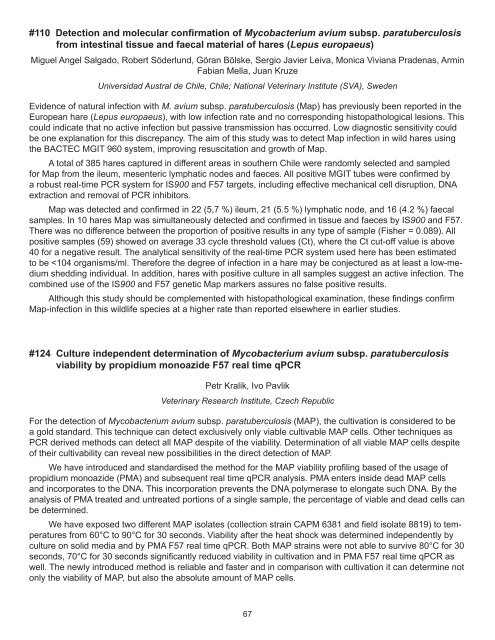Proceedings of the 10th International Colloquium on Paratuberculosis
Proceedings of the 10th International Colloquium on Paratuberculosis
Proceedings of the 10th International Colloquium on Paratuberculosis
You also want an ePaper? Increase the reach of your titles
YUMPU automatically turns print PDFs into web optimized ePapers that Google loves.
#110 Detecti<strong>on</strong> and molecular c<strong>on</strong>firmati<strong>on</strong> <str<strong>on</strong>g>of</str<strong>on</strong>g> Mycobacterium avium subsp. paratuberculosis<br />
from intestinal tissue and faecal material <str<strong>on</strong>g>of</str<strong>on</strong>g> hares (Lepus europaeus)<br />
Miguel Angel Salgado, Robert Söderlund, Göran Bölske, Sergio Javier Leiva, M<strong>on</strong>ica Viviana Pradenas, Armin<br />
Fabian Mella, Juan Kruze<br />
Universidad Austral de Chile, Chile; Nati<strong>on</strong>al Veterinary Institute (SVA), Sweden<br />
Evidence <str<strong>on</strong>g>of</str<strong>on</strong>g> natural infecti<strong>on</strong> with M. avium subsp. paratuberculosis (Map) has previously been reported in <str<strong>on</strong>g>the</str<strong>on</strong>g><br />
European hare (Lepus europaeus), with low infecti<strong>on</strong> rate and no corresp<strong>on</strong>ding histopathological lesi<strong>on</strong>s. This<br />
could indicate that no active infecti<strong>on</strong> but passive transmissi<strong>on</strong> has occurred. Low diagnostic sensitivity could<br />
be <strong>on</strong>e explanati<strong>on</strong> for this discrepancy. The aim <str<strong>on</strong>g>of</str<strong>on</strong>g> this study was to detect Map infecti<strong>on</strong> in wild hares using<br />
<str<strong>on</strong>g>the</str<strong>on</strong>g> BACTEC MGIT 960 system, improving resuscitati<strong>on</strong> and growth <str<strong>on</strong>g>of</str<strong>on</strong>g> Map.<br />
A total <str<strong>on</strong>g>of</str<strong>on</strong>g> 385 hares captured in different areas in sou<str<strong>on</strong>g>the</str<strong>on</strong>g>rn Chile were randomly selected and sampled<br />
for Map from <str<strong>on</strong>g>the</str<strong>on</strong>g> ileum, mesenteric lymphatic nodes and faeces. All positive MGIT tubes were c<strong>on</strong>firmed by<br />
a robust real-time PCR system for IS900 and F57 targets, including effective mechanical cell disrupti<strong>on</strong>, DNA<br />
extracti<strong>on</strong> and removal <str<strong>on</strong>g>of</str<strong>on</strong>g> PCR inhibitors.<br />
Map was detected and c<strong>on</strong>firmed in 22 (5,7 %) ileum, 21 (5.5 %) lymphatic node, and 16 (4.2 %) faecal<br />
samples. In 10 hares Map was simultaneously detected and c<strong>on</strong>firmed in tissue and faeces by IS900 and F57.<br />
There was no difference between <str<strong>on</strong>g>the</str<strong>on</strong>g> proporti<strong>on</strong> <str<strong>on</strong>g>of</str<strong>on</strong>g> positive results in any type <str<strong>on</strong>g>of</str<strong>on</strong>g> sample (Fisher = 0.089). All<br />
positive samples (59) showed <strong>on</strong> average 33 cycle threshold values (Ct), where <str<strong>on</strong>g>the</str<strong>on</strong>g> Ct cut-<str<strong>on</strong>g>of</str<strong>on</strong>g>f value is above<br />
40 for a negative result. The analytical sensitivity <str<strong>on</strong>g>of</str<strong>on</strong>g> <str<strong>on</strong>g>the</str<strong>on</strong>g> real-time PCR system used here has been estimated<br />
to be






